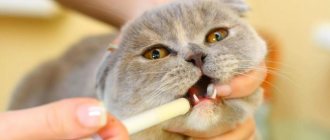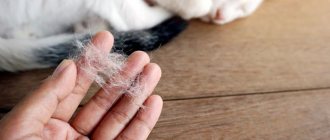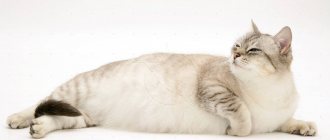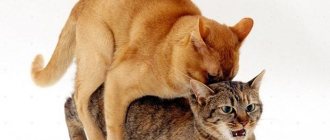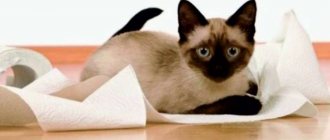Activated carbon is widely used in veterinary practice to combat metabolic disorders. It is recommended to give medicine to cats in the form of a powder or suspension, but you can also resort to tablets. Despite the effectiveness of the pharmaceutical product, it has contraindications for use, so its use must be agreed with a veterinarian.
Properties of the drug
The medicine is obtained from charcoal that has undergone heat treatment. For diarrhea, poisoning and vomiting, this absorbent can be used not only for people; activated charcoal can be given to a kitten and older pets. The medicine is most effective when eliminating toxic substances that have not yet left the gastrointestinal tract. Manufacturers add starch and glucose to the crushed coal powder, which, when entering the body, stabilizes basic processes and also reduces stress, which is often observed during poisoning. Carbon absorbents normalize the functioning of the kidneys and liver. The medicine is produced in the form of suspension, powder, tablets and capsules. It is better to give activated charcoal to kittens in powder form or pre-grind the tablets into a powder.
Special poisons
Many cleaning products used in everyday life (fluids for washing sinks and toilets, solvents, etc.) are potent poisons. Poisoning can occur either due to the negligence of the owners or as a result of the pranks of children who doused the cat with such a substance. In such cases, you should not induce vomiting, but give the cat vegetable oil (1-2 tablespoons) and wash the affected areas with baby shampoo.
Flea collars, shampoos and aerosols containing insecticides - organophosphates and carbamates - can pose a danger to cats. The means of controlling cockroaches - various traps - are also dangerous. A cat can become poisoned by deciding to chew on a collar, or by licking insecticide from its fur. The nervous system is primarily affected.
Symptoms: excessive salivation, diarrhea, vomiting, drowsiness, convulsions, convulsions, tremors. In such cases, you need to quickly induce vomiting, give polysorb or activated carbon, rinse the stomach and urgently take the cat to the veterinary clinic. Phospholithin or atropine can be used as antidotes for poisoning with organophosphorus compounds.
Among other household hazards, naphthylthiourea (ratsid) should be highlighted - a cat can be poisoned by either ingesting poisoned bait or eating a poisoned rat or mouse.
The symptoms of such poisoning and first aid for it are the same as for poisoning with insecticides.
In case of arsenic poisoning, some compounds of which are used as pesticides (for example, Parisian greens), death can occur within 2-4 hours, before any symptoms develop. If you suspect arsenic poisoning, induce vomiting and urgently take the affected animal to a veterinary clinic. The antidote for arsenic poisoning (as well as bismuth, mercury, zinc, etc.) is unithiol (10% solution orally, at the rate of 50 mg per kg).
In case of poisoning with barium carbonate (barium carbonate), it is necessary to induce vomiting as quickly as possible. A 1% solution of sodium or magnesium sulfate is used as an antidote.
Take the cat to the veterinary clinic immediately.
In case of poisoning with warfarin (zoocoumarin), an anticoagulant used to control rodents, give the cat vitamin K (Vicasol). The doctor will inject the cat intravenously with gamavit, or a solution of calcium chloride, glucose and ascorbic acid. Sometimes a blood transfusion is used to save an animal.
Many cats like the sweetish taste (most likely not even a taste, but a smell) of antifreeze (ethylene glycol), used as an additive to coolant (antifreeze) and antifreeze fluid in car windshield washers. Antifreeze poisoning is accompanied by vomiting, loss of coordination, weakness, irreversible kidney damage, coma and often death. If a cat drank antifreeze in front of your eyes, you need to induce vomiting as quickly as possible and rinse its stomach. Intravenous administration of wine alcohol and other alcohols is used as an antidote. This is due to the fact that antifreeze itself is not very dangerous for cats, but immediately after it is processed by the liver, one of the resulting metabolites - oxalic acid - kills the cat in a matter of hours. Oxalic acid is not absorbed by the cat's body and is therefore extremely toxic to it. Entering the urinary tract, it literally burns out its individual parts, not to mention the formation of crystals (oxalates) with calcium, which block the urinary tract.
In case of poisoning with zinc phosphide, a zoocide often used to control rats, as well as field mice and other crop pests, immediately rinse the cat’s stomach and induce vomiting, then give Polysorb, saline laxatives. Inject camphor and gamavit subcutaneously (it is better if the doctor administers it intravenously).
Cats can also become poisoned during trips to their dachas, country and foreign trips, by tasting some poisonous plant. In addition, many cats (especially those who are never allowed outside) like to nibble on the leaves of decorative indoor plants. Most often, cats eat grass in order to then, by regurgitating, remove clumps of hair from the stomach, which they usually swallow when licking.
The effects of eating the “wrong” plants can be different: from allergies (allergic dermatitis, swelling of the oral mucosa, bronchitis, rhinitis, gastroenteritis, etc.), digestive disorders (vomiting, diarrhea, abdominal pain), eye and skin irritation to damage to the nervous system (convulsions, impaired coordination of movements, hallucinations) and kidneys (renal failure), and disorders of cardiovascular activity (collapse, heart failure).
Symptoms: profuse salivation, often accompanied by vomiting. Possible depression of respiratory function and disruption of cardiac function.
Treatment: if vomiting does not occur on its own, try to induce it yourself, give a moistened tablet of activated charcoal and contact your veterinarian.
Benefits and harms
The drug will help an animal that has eaten something wrong.
The advantage of using this medication lies in the fact that its systematic use helps prevent the occurrence of food poisoning. In addition, the medicine is also effective for cats in cases where metabolic disorders have already occurred. The benefits of activated carbon lie in the removal of heavy metal salts and relief from bloating after eating a large amount of food. However, the medication can also cause harm to the body. If given to cats over a long period, bowel problems may develop. In addition, long-term use of pharmaceuticals sometimes causes leaching of useful substances from the body.
What can poison a dog?
- Poor quality, spoiled food. No, you cannot feed your dog missing food. The stomach of animals is by no means “tinned”; they can also become ill from sour milk or moldy bread.
- All kinds of household chemicals. We humans know that we should not drink shampoos, but how do animals know this? The cause of poisoning can be household, cosmetic and chemical products left unattended.
- I. If your dog is not trained to ignore treats scattered on the streets, drive him around with a muzzle. Unfortunately, the animal can eat not only dead meat, but also treats with poison scattered by dog hunters.
- Snakes and poisonous insects. A viper can bite a dog too - and it is important to see what kind of viper bit your pet, because it depends on what kind of serum the veterinarian will inject. No matter how tempting it may be, try not to let your dog off leash in unfamiliar areas that are potentially infested with snakes or poisonous insects.
- Medicines. Finally, the dog may overdose on the medication. The veterinarian gives a clear dosage, which is why self-medication is so dangerous. Paracelsus also said: “Everything is poison and everything is medicine”: this means that in a small dose a tablet can bring relief, but in a large dose it can become deadly.
Preparation and application
With this drug you can give an animal an enema.
First of all, veterinarians from the Zoovet clinic recommend giving your pets an enema with an activated carbon suspension. To prepare it, you will need to take about 20 g of powder or tablets that have been previously crushed and dissolve them in warm water. The enema is administered using a baby syringe. It is permissible to resort to this manipulation for any type of intoxication of the body.
Once the enema has been done, the cat will need to be given activated charcoal orally. It is recommended to adhere to the following dosage: 1 g of the powdered state of the medicine per 1 kg of body weight of the pet. For a kitten who is not yet six months old, one crushed tablet is enough. The medication will need to be mixed with purified water at room temperature to obtain a mixture that has the consistency of fairly thin sour cream. Then the cat owner needs to arm himself with a syringe, having first removed the needle from it, and draw the resulting mixture into it.
The animal will need to be seated on your lap so that its back rests against the owner's stomach. You should carefully lift the cat's head and pull back the lip. Next, you need to insert a syringe into the hole between the jaws and inject the medication. It is important to wait until the cat makes a swallowing movement, stroking it in the neck area, after which you can lower the pet’s head.
The procedure will need to be repeated after 2 hours. On average, it is recommended to do about 4 such manipulations. Once your cat stops vomiting, mixing activated charcoal with water is no longer recommended. Veterinarians advise giving the whole tablet, placing it on the root of the cat’s tongue.
How to calculate dosage
In pharmacies, the drug is most often found in the form of black porous tablets of 250 mg. It is produced for humans, so the instructions do not contain instructions for treating animals. Each tablet is calculated for 10 kg of weight. An adult cat is given 0.5 - 1 piece at a time, half is enough for a kitten. Increasing the dose by 2 times does not bring negative side effects; if it is greatly exceeded, the cat develops constipation. If charcoal is not removed within a day, then the reverse process begins: toxins from it return to the intestines and treatment becomes useless.
The frequency and duration of administration depends on the severity of the animal’s condition. On average, coal is given 3–4 times a day with an interval of 3 hours for 3–7 days. If improvements are noticed the next day, the dose is halved. If there is no result after 5 days, veterinary attention and additional medications for treatment will be required. The absorbent neutralizes toxins in the intestines, but does not affect them after they enter the blood.
Is it acceptable to use on pregnant and lactating cats?
For females expecting offspring, the use of this drug is allowed.
The medication is completely eliminated from the body, so veterinarians note that it is not dangerous to the health of both the cat and its offspring. Often during pregnancy, pets experience vomiting or diarrhea after childbirth. In such a situation, veterinarians often prescribe the use of activated carbon.
Treatment of poisoning in a veterinary clinic
Before starting to treat a cat with poisoning, the doctor must obtain from the owner information about what, in the owner’s opinion, the cat was poisoned with, whether there was vomiting (it would be a good idea for the owner to take a sample of the vomit with him), whether there was diarrhea, what chronic diseases your cat has, and etc. A quick clinical examination is carried out and resuscitation measures begin.
The cat is given a drip with 40% glucose. General stimulants (Gamavit, Katazol, Vitam, Vitamin C) and detoxifying drugs, hepatoprotectors (Essentiale), cardiac drugs (camphor, caffeine, cordiamine), antiemetics (Cerucal), and antidiarrheal drugs are administered intravenously. In case of severe poisoning, the drip to the cat is repeated every other day.
To normalize water-salt metabolism, the cat is injected intravenously with Ringer's solution. When treating poisoning, veterinary specialists also use antispasmodics - no-shpa, baralgin.
In order to speed up the elimination of poisons that have entered the body, diuretics are prescribed.
Depending on the general condition of the body, a veterinarian may additionally resort to symptomatic treatment.
Adverse reactions
Rarely, pets may develop constipation in response to drug therapy.
Mostly activated carbon and Polysorb are well tolerated by the cat’s body and do not cause side effects. However, some pets experience a deterioration in the absorption of hormones, vitamins, microelements and other beneficial components. It is possible that prolonged constipation may occur, as a result of which breakthrough diarrhea or hemorrhoids often develop. Activated carbon can also affect the activity of gastric juice, reducing it. The safest side effect is considered to be a change in the color of stool to black.
Can cats have activated charcoal?
If your cat ingests a toxin, consult your veterinarian immediately. In most cases, you need to immediately induce vomiting to remove the poison from the body and only then give activated charcoal to destroy the toxicant remaining in the intestines.
The drug is taken orally . Both adult cats and kittens are very fussy about their food and it is unlikely that they will voluntarily eat charcoal mixed into their food. In such a situation, it is better to organize the administration of a liquid form of the drug; it can be injected into the animal’s mouth.
For prevention, one tablet per day is enough
Pharmaceutical analogues
Pharmacy chains offer a wide selection of medications that have a similar mechanism of action on the cat’s body. Carbopect and Polysorb will help you cope with poisoning and other metabolic disorders. At the same time, it is important for pet owners to pay attention to the fact that it is strictly prohibited to independently replace a medication prescribed by a veterinarian, even with a similar one. The decision to replace can only be made by the doctor, who takes into account the presence of concomitant diseases in the cat, age and individual characteristics of its body.
General information
Diarrhea (popularly called diarrhea) is a digestive disorder that requires mandatory treatment. With each bowel movement, the pet's body loses a large amount of fluid, weakens and becomes depleted. If not treated promptly, diarrhea can lead to the death of the animal.
Diarrhea is often accompanied by nausea, abdominal pain, and vomiting. The animal experiences discomfort, anxiety, stress. He loses his appetite.
Diarrhea in a cat: how to properly treat an upset stomach
Diarrhea may also be accompanied by:
- fever;
- flatulence;
- fatigue, lethargy;
- nausea;
- vomiting;
- bloody discharge.
Diarrhea is not an independent pathology, it is only a symptom of existing health problems in your pet.
